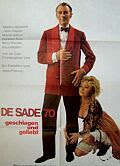
Pierre Chevalier (aka Peter Knight) directed Jack Taylor through remote control by inserting footage of him into the 1974 Eurocine composite THE HOUSE OF THE LOST DOLLS. Ten years later Chevalier and Taylor worked together in the flesh on the Eurocine-backed PANTHER SQUAD, where Jack teamed up with co-producer Sybil Danning to save the World Space Program.

After appearing in AGENTE SIGMA 3--MISSIONE GOLDWATHER Jack Taylor went on to appear in numerous examples of European Trash Cinema as well as the odd Hollywood mainstream film (CONAN THE BARBARIAN; THE NINTH GATE) and became one the most familiar faces of the 1970s Spanish Horror boom.

Or how a 1960's Eurospy film devolved into an incredibly sleazy sexploitation epic featuring kidnapping, rape and white slavery via a Eurocine composite...
.jpg)
Maison des filles perdues, La (1974)
It's so bad that it's... well, let's just say that it's So Bad! But who to blame? THE HOUSE OF THE LOST DOLLS/GIRLS began its existence as an obscure Eurospy film made in Italy and co produced by Eurocine (we'll be copying this over to THE EUROCINE ARCHIVES).

Agent Sigma 3 (Jack Taylor) pursues the villain to his death! Taylor appeared in my favorite Jess Franco film NECRONOMICON (1967) and ten subsequent JF projects.*

AGENTE SIGMA 3, MISSIONE GOLDWATHER was the 1960's Eurospy item cannibalized for THE HOUSE OF THE LOST DOLLS (1974)and (OASIS OF THE LOST GIRLS (1981), among others.
Here's an expanded-updated version of an archived 2006 blog:
THE HOUSE OF THE LOST DOLLS (1974): A Franco-Italian production. Pierre Chevalier (THE INVISIBLE DEAD) actually "directed" this Eurocine composite under the name Peter Knight. This used to be listed by VSOM as a "Jess Franco" film in their old 1990's era catalogues, and the IMDB lists Franco as co-writer of the "script."
I fell for it and purchased one to discover footage from a 1967 Italian spy film featuring Jack Taylor AGENTE SIGMA 3: MISSIONE GOLDWATHER composited with footage from a French-lensed film about white slavers operating in Paris and Marseilles, presumably a Chevalier directed effort, title as yet unknown. BOTH of these feature Silvia Solar as a femme fatale in separate roles filmed in two different decades! So, it all gets very confusing. Sandra Julien (THE SHIVER OF THE VAMPIRE) also appears as a mini skirted undercover agent whom white slave kingpin (and frequent 1970's era Jess Franco performer) Olivier Mathot attempts to rape.
There also appears to be footage from a third unknown film in here of agents raiding a cargo ship and breaking up a rape of a nude slave in bondage below deck. It all adds up to a supersleazefest with music by Daniel J. White and uncredited cues from Bruno Nicolai's great score for EUGENIE DE SADE (1970, the cue I'm thinking of plays over Soledad Miranda's change into that wild rain gear before the first murder. The upbeat trumptet tempo is heard over during a nightclub scene, originally in SIGMA 3, in HOUSE.).
Footage from this composite was later mixed with scenes from an actual Jess Franco film, OPALO DE FUEGEO (1978) and was re released with newly shot footage by "John O'Hara" as OASE DER GEFANGENEN FRAUEN, at least that's the title of the German language version which was released on DVD a few years ago by the German company, X-RATED KULT DVD. There are also Spanish and French versions.
The French version is L'OASIS DES FILLES PERDUES. The new footage features Francoise Blanchard, probably best know as the title character in Rollin's LA MORTE VIVANTE (1982). "John O'Hara" is actually the Spanish director Jose Jara. It opens in a disco as Blanchard and friends party the night away only to be invited to an apartment by several sleazy looking males. Once there they are drugged with spiked champagne (these scenes are very similar in staging to the way the kidnappers in Jess Franco's own WILDE LUST/MADCHEN IM NACHTVERKEHR, a 1976 hardcore produced by Erwin C. Dietrich, who is sometimes credited with the direction). They are then taken onto a ship and molested in the hold by Yul Sanders (Claude Boisson), this 1980s footage is intercut with Chevalier's 70s footage of other actresses in the hold getting the same treatment from a obviously younger Yul Sanders. It goes on and on like intercutting footage from three, maybe four, directors and the SIGMA 3 reappears, only this time with different dubbing and scoring.
A prolific Eurotrash performer from the 1950s onward Silvia Solar's birth name was Geneviève Couzain.
Jack Taylor and SIGMA 3 director Gian Paolo Callegari are not credited on the English language print of THE HOUSE OF THE LOST DOLLS.
(c) Robert Monell, 2008































